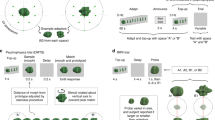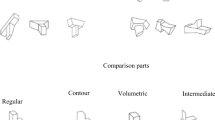Abstract
Humans are experts at shape processing. This expertise has been learned and fine tuned by actively manipulating and perceiving thousands of objects during development. Therefore, shape processing possesses an active component and a perceptual component. Here, we investigate both components in six experiments in which participants view and/or interact with novel, parametrically defined 3D objects using a touch-screen interface. For probing shape processing, we use a similarity rating task. In Experiments 1–3, we show that active manipulation leads to a better perceptual reconstruction of the physical parameter space than judging rotating objects, or passively viewing someone else’s exploration pattern. In Experiment 4, we exploit object constancy—the fact that the visual system assumes that objects do not change their identity during manipulation. We show that slow morphing of an object during active manipulation systematically biases similarity ratings—despite the participants being unaware of the morphing. Experiments 5 and 6 investigate the time course of integrating shape information by restricting the morphing to the first and second half of the trial only. Interestingly, the results indicate that participants do not seem to integrate shape information beyond 5 s of exploration time. Finally, Experiment 7 uses a secondary task that suggests that the previous results are not simply due to lack of attention during the later parts of the trial. In summary, our results demonstrate the advantage of active manipulation for shape processing and indicate a continued, perceptual integration of complex shape information within a time window of a few seconds during object interactions.









Similar content being viewed by others
References
Biederman I (1987) Recognition-by-components: a theory of human image understanding. Psychol Rev 94:115
Borg I, Groenen PJF (2005) Modern multidimensional scaling: theory and applications. Springer, Berlin
Brady TF, Konkle T, Alvarez G (2011) A review of visual memory capacity: beyond individual items and toward structured representations. J Vis 11(5):4
Bülthoff HH, Edelman S (1992) Psychophysical support for a 2-D view interpolation theory of object recognition. Proc Natl Acad Sci USA 89:60–64
Chuang LL, Vuong QC, Bülthoff HH (2012) Learned non-rigid object motion is a view-invariant cue to recognizing novel objects. Frontiers Comput Neurosci 6(26):1–8
Cooke T, Jäkel F, Wallraven C, Bülthoff HH (2007) Multimodal similarity and categorization of novel, three-dimensional objects. Neuropsychologia 45:484–495
Craddock M, Martinovic J, Lawson R (2011) An advantage for active versus passive aperture-viewing in visual object recognition. Perception 40:1154–1163
Cutzu F, Edelman S (1998) Representation of object similarity in human vision: psychophysics and a computational model. Vis Res 38:2227–2257
Dopjans L, Bülthoff HH, Wallraven C (2012) Serial exploration of faces: comparing vision and touch. J Vis 12:1–14
Edelman S (1999) Representation and recognition in vision. MIT Press, Cambridge
Edelman S, Shahbazi R (2012) Renewing the respect for similarity. Frontiers Comput Neurosci 6:45
Foster DH, Gilson SJ (2002) Recognizing novel three–dimensional objects by summing signals from parts and views. Proceedings of the Royal Society of London. Ser B Biol Sci 269:1939–1947
Gaißert N, Wallraven C, Bülthoff HH (2010) Visual and haptic perceptual spaces show high similarity in humans. J Vis 10(11:2):1–20
Gaißert N, Bülthoff HH, Wallraven C (2011) Similarity and categorization: from vision to touch. Acta Psychol 138:219–230
Goodale MA (2011) Transforming vision into action. Vision Res 51:1567–1587
Grimes J (1996) On the failure to detect changes in scenes across saccades. In: Akins K (ed) Perception (Vancouver studies in cognitive science). Oxford University Press, New York, pp 89–110
Harman KL, Humphrey GK, Goodale MA (1999) Active manual control of object views facilitates visual recognition. Curr Biol 9:1315–1318
James KH, Humphrey GK, Goodale MA (2001) Manipulating and recognizing virtual objects: where the action is. Can J Exp Psychol 55:111–120
James KH, Humphrey GK, Vilis T, Corrie B, Baddour R, Goodale MA (2002) “Active” and “passive” learning of three-dimensional object structure within an immersive virtual reality environment. Behav Res Methods Instrum Comput 34:383–390
Lawson R, Bülthoff HH (2006) Comparing view sensitivity in shape discrimination with shape sensitivity in view discrimination. Percept Psychophys 68:655–673
Lawson R, Bülthoff HH (2008) Using morphs of familiar objects to examine how shape discriminability influences view sensitivity. Percept Psychophys 70(5):853–877
Meijer F, Van der Lubbe RH (2011) Active exploration improves perceptual sensitivity for virtual 3D objects in visual recognition tasks. Vis Res 51:2431–2439
Myers L, Sirois MJ (2004) Spearman correlation coefficients, differences between. In: Kotz S, Read CB, Balakrishnan N, Vidakovic B (eds) Encyclopedia of statistical sciences. Wiley, Berlin
Pereira AF, James KH, Jones SS, Smith LB (2010) Early biases and developmental changes in self-generated object views. J Vis 10(22):1–13
Sasaoka T, Asakura N, Kawahara T (2010) Effect of active exploration of 3-D object views on the view-matching process in object recognition. Perception 39:289–308
Shepard RN (1987) Toward a universal law of generalization for psychological science. Science 237:1317–1323
Shepard RN (2001) Perceptual-cognitive universals as reflections of the world. Behav Brain Sci 24:581–601
Thorpe S, Fize D, Marlot C (1996) Speed of processing in the human visual system. Nature 381:520–522
Tversky A (1977) Features of similarity. Psychol Rev 84:327–352
Ullman S (1979) The interpretation of structure from motion. Proc R Soc Lond Ser B Biol Sci 203:405–426
Vuong QC, Friedman A, Read JC (2012) The relative weight of shape and non-rigid motion cues in object perception: a model of the parameters underlying dynamic object discrimination. J Vis 12(3):1–16
Wallis G (2002) The role of object motion in forging long-term representations of objects. Vis Cognit 9:233–247
Wallis G, Bülthoff HH (2001) Effects of temporal association on recognition memory. Proc Natl Acad Sci USA 98:4800–4804
Wallis G, Backus BT, Langer M, Huebner G, Bülthoff H (2009) Learning illumination-and orientation-invariant representations of objects through temporal association. J Vis 9(7):6
Wallraven C (2007) A computational recognition system grounded in perceptual research. Logos Verlag, Berlin. ISBN 978-3-8325-1662-8
Acknowledgments
This research was supported by the World Class University (WCU) program through the National Research Foundation of Korea funded by the Ministry of Education, Science, and Technology (R31-1008-000-10008-0). We gratefully acknowledge the help of Chris West (http://www.west-racing.com/) who donated a version of his Mega-Fiers package for Unity for this project.
Author information
Authors and Affiliations
Corresponding author
Rights and permissions
About this article
Cite this article
Lee, H., Wallraven, C. Exploiting object constancy: effects of active exploration and shape morphing on similarity judgments of novel objects. Exp Brain Res 225, 277–289 (2013). https://doi.org/10.1007/s00221-012-3368-1
Received:
Accepted:
Published:
Issue Date:
DOI: https://doi.org/10.1007/s00221-012-3368-1




